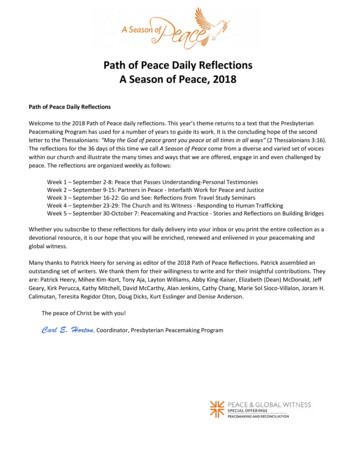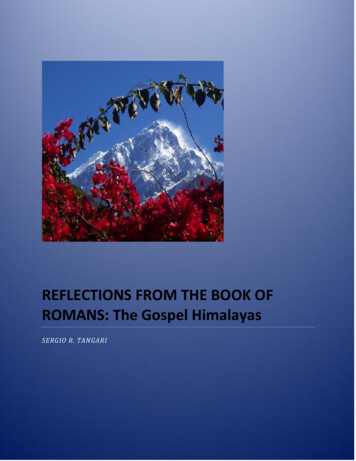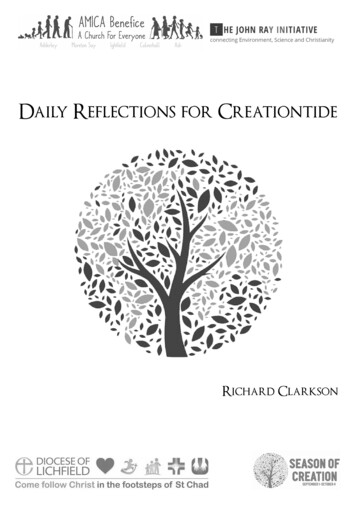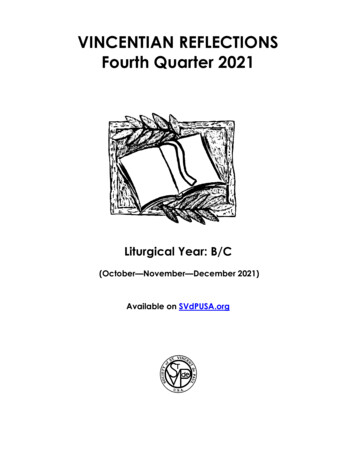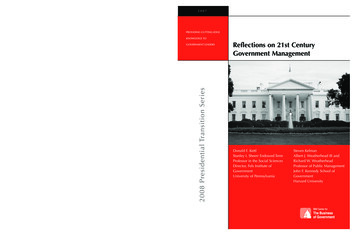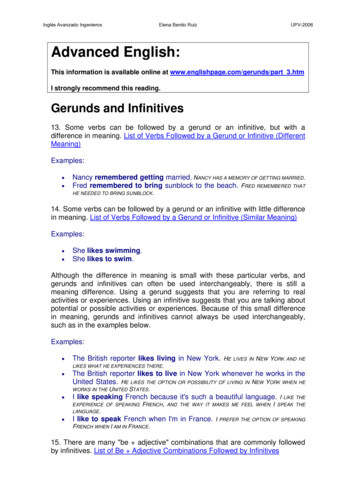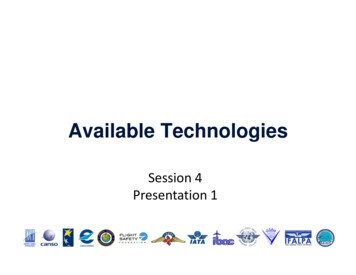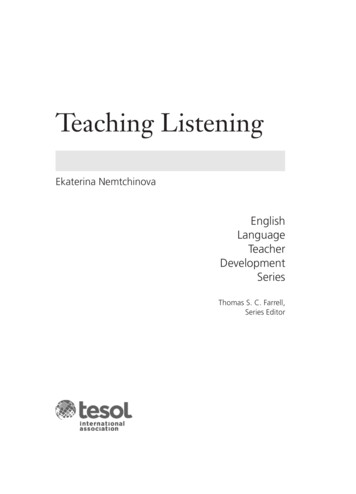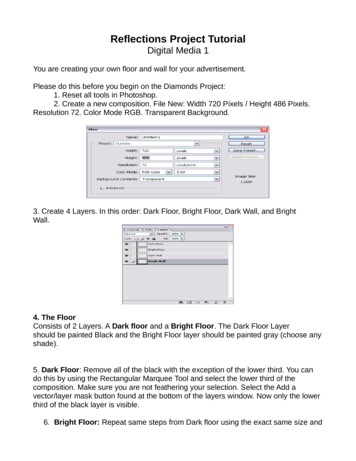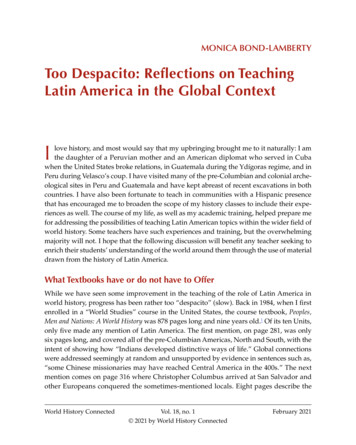
Transcription
MONICA BOND-LAMBERTYToo Despacito: Reflections on TeachingLatin America in the Global ContextIlove history, and most would say that my upbringing brought me to it naturally: I amthe daughter of a Peruvian mother and an American diplomat who served in Cubawhen the United States broke relations, in Guatemala during the Ydígoras regime, and inPeru during Velasco’s coup. I have visited many of the pre-Columbian and colonial archeological sites in Peru and Guatemala and have kept abreast of recent excavations in bothcountries. I have also been fortunate to teach in communities with a Hispanic presencethat has encouraged me to broaden the scope of my history classes to include their experiences as well. The course of my life, as well as my academic training, helped prepare mefor addressing the possibilities of teaching Latin American topics within the wider field ofworld history. Some teachers have such experiences and training, but the overwhelmingmajority will not. I hope that the following discussion will benefit any teacher seeking toenrich their students’ understanding of the world around them through the use of materialdrawn from the history of Latin America.What Textbooks have or do not have to OfferWhile we have seen some improvement in the teaching of the role of Latin America inworld history, progress has been rather too “despacito” (slow). Back in 1984, when I firstenrolled in a “World Studies” course in the United States, the course textbook, Peoples,Men and Nations: A World History was 878 pages long and nine years old.1 Of its ten Units,only five made any mention of Latin America. The first mention, on page 281, was onlysix pages long, and covered all of the pre-Columbian Americas, North and South, with theintent of showing how “Indians developed distinctive ways of life.” Global connectionswere addressed seemingly at random and unsupported by evidence in sentences such as,“some Chinese missionaries may have reached Central America in the 400s.” The nextmention comes on page 316 where Christopher Columbus arrived at San Salvador andother Europeans conquered the sometimes-mentioned locals. Eight pages describe theWorld History ConnectedVol. 18, no. 1 2021 by World History ConnectedFebruary 2021
Bond-Lamberty Too DespacitoImage 1: Moray, an Incan agricultural testing site in the Peruvian highlands. Author’s photograph.European exploration and conquest of the Americas, with little mention of the effects ontheir inhabitants. The region is again discussed on page 429 where four pages are devotedto describing the “rigid colonial society in Latin America.” In the subsequent section the“Age of Revolution,” four pages are devoted to its effects on Latin American settler society.Latin America next comes up on page 573 in the discussion of imperialism (after Oceania!), nine pages cover the “unsettled conditions” which “led to American intervention”in the region. The last mention of Latin America is on page 815, addressing the “unstableeconomic and political conditions” caused by the Cold War. I was fortunate in that myteacher, Mrs. Schepps, had been to Latin America and chose to spend time on some ofpre-Columbian societies.Some few textbooks today go beyond the standard narrative of, “they were there, theywere conquered, they gained independence and then they were economically reconqueredand then the Cold War.” Nevertheless, as a teacher of world history, I found that I needed2
Bond-Lamberty Too Despacitoto supplement textbooks with additional information and images, some based on my ownresearch. However, this is problematic, as many teachers do not have time for research orother means of deepening their understanding of the region’s history sufficiently to employteaching examples drawn from Latin American history. Hard pressed teachers can and domake use of their own experiences in high school classes, such as mine with Mrs. Schepps,as a benchmark of what they need to teach their own students, but few have had the goodfortune to have had such experiences. Understandably, this leaves Latin America—oftenunknown to them other than in the context of immigration—getting the short end of thestick. Even those teachers with the time and inclination to increase their coverage of theregion face the dilemma that any additional material might reduce the well-establishedcoverage of topics at their school, such as the Eurocentric “Age of Absolutism” imbeddedin traditional survey courses.Acquiring a Compelling NarrativeAnother part of the problem facing world history teachers without sufficient understanding of Latin American history is the lack of an overarching narrative like those that can befound about Europe, China, or the Middle East. Teachers new to teaching World History canget the broad strokes of pre-Colombian civilizations from their textbooks, but not the latestscholarly findings about the Maya (unless they read recent issues of National Geographic).They can learn more about the Columbian Exchange by reading Alfred W. Crosby’s seminalbook on the subject and/or Charles Mann’s 1493.2 However, many teachers new to worldhistory despair of ever “knowing everything.” The best thing that can happen is that theyrealize that they simply cannot know everything and definitely not immediately! Rather,they might begin by trying to learn a little bit of more about Latin American from whatthey have at hand. Teachers who have sizeable populations of students whose families hailfrom Latin America would do well to focus on that region sooner rather than later in theircourses, so as to encourage students themselves to ask for more content and discussion.So, what is a conscientious teacher to do? For starters one could do worse than start bywatching John Leguizamo’s Latin History for Morons.3 It is funny and, while it veers into UShistory, it does give one some broad strokes and a beginner’s bibliography. Be forewarned:most schools will not permit showing it in high school classrooms given the pervasive foullanguage throughout. You can also build on students’ own knowledge. Many high schoolstudents will have heard of Latin America from reading the Time Warp Trio’s book Me OhMaya or the Magic Tree House’s trip to Machu Picchu in Late Lunch with Llamas. Of course,you also need to undo the damage done by films like The Emperor’s New Groove and IndianaJones and the Kingdom of the Crystal Skull.43
Bond-Lamberty Too DespacitoMicro-AdditionsAnother strategy is what I call micro-additions—just add a little spice to the narrative. Fora unit on early civilizations, discuss Norte Chico (Caral), which moves the timeline of theAmericas back considerably. When discussing the Muslim Agricultural Revolution compareit to the spread of American crops like corn or the domestication of the trees in the Amazon(see for example the discussion in Charles Mann’s 1491).5 No discussion of the conquestof Mexico and Central America should leave out the Nahua who were given encomiendasby the Spanish king for their service against the Mexica (see Laura Matthew and MichelOudik’s Indian Conquistadors).6 Wars for independence in Latin America should be prefacedwith a discussion of Tupac Amaru II. For those not familiar with him, you might try thegraphic history about his brother’s life: Witness to the Age of Revolution.7 The Smithsonianhas a great music collection that can be used to show the musical effects of migration toLatin America in the 19th century.8 These are not the only examples that can be used; mystudents admittedly get a generous focus on Peruvian history given my heritage and interests. If it interests you, you can make it interesting to them.Image 2: At Caral, a city of the Norte Chico civilization in Peru. Author’s photograph.4
Bond-Lamberty Too DespacitoStudent ResearchAnother tactic: have your students do some of the researching. I usually give my studentsinquiry-like research projects as culminating or review projects. One approach would be tofocus on a theme like environmental history or social history and have them do a regionalcomparison. There are great resources on the environmental consciousness of the Inca orthe role of women in Latin America where women have been president already.9 Anotherapproach is to assign students the task of editing the sections of their textbooks that coverLatin America. If you have older texts handy, they can prove useful as a comparison. Onthe other hand, if you can get your hands on syllabi from university survey courses onLatin America, some of the articles that are assigned in these courses can prove useful;the students themselves can determine what is being left out. Such inquiries can inspirecritical thinking at a higher level. Finally, having your students watch Harvest of Empire isa good starting point for a discussion of the treatment of modern Latin American historyin textbooks.10 This documentary has a definite political point of view that students couldtry their hands at supporting or refuting.Advanced Placement World History IdeasFor those teaching AP World History, below is a list of lessons, articles or images (not mentioned above) that one could incorporate into one’s course.Unit 0—Be sure to mention at least one society like the Olmecs, Teotihuacan,Nazca.Unit 1—Global Tapestry—1200–1450—Have your students try to defend orrefute the central argument in “Cereals, Appropriability and Hierarchy” byMayshar and Moav or a simplified version of their argument.11Unit 2—Networks of Exchange—be sure to address pre-Colombian traderoutes, World History for Us All (https://whfua.history.ucla.edu) has a niceunit on spheres of interaction in the Americas as does the OER Project. Makingstudents cognizant of the interconnectedness between the different societiesis helpful in explaining how disease beats Europeans to some parts of theAmericas like the Inca.12Unit 3—Land-Based Empires—have students examine the Inca’s economicsystem (e.g. no merchants, communal agriculture, social safety net) and see ifit fits the definition of socialism, as argued by authors like Louis Baudin or itdoes not, as argued by Peruvian historian Maria Rostworowski.13Unit 4—Transoceanic Interconnections—include some items not commonlylisted among the trade goods—e.g. cochineal or have your students analyze animage reflecting the power of the maroon communities/Palenques, etc.145
Bond-Lamberty Too DespacitoUnit 5—Revolutions—Have students debate the role of pre-Columbian societies (e.g. Iroquois) in influencing Enlightenment ideals; or have studentsanalyze the role of Manuela Saenz, la libertadora del Libertador or for an earlierinfluence they can look at Micaela Bastidas, the wife of Túpac Amaru II.15Unit 6—Consequences of Industrialization—compare the depletion ofresources such as guano (bird feces exported for fertilizer) to those in otherregions; examine the influence of other societies on Latin American food e.g.the so-called “Peruvian chicken,” uses soy sauce brought by Chinese andJapanese immigrants in the 19th Century; or compare instances of xenophobiain the US, Canada and Latin America.16Unit 7—Global Conflict—analyze the effects of the Great Depression on LatinAmerica. Or have students investigate the actions taken during the World WarII, as to why Peru sent Japanese (citizens or not) to the U.S. for internment,along with Japanese Americans, in response to an American request.17Unit 8—Cold War and Decolonization—this unit is particularly useful inmaking connections to the migration of Latin Americans to the US with CIAactivity in Guatemala, El Salvador and Nicaragua being a particularly usefulplace to start. Be sure to bring up how some countries elected the same groupsthat the US fought against for so long. Harvest of Empire (cited above) is alsouseful here.Unit 9—Globalization—have students analyze the reasons behind the worldwide popularity of some Latin American songs—Macarena, Despacito, etc. Havestudents research the aid projects being done in Latin America by other countries such as China and Japan, and others.ConclusionWhen I attended elementary school in the United States, I was impressed by the growingpresence of people of Latin American descent. Nowadays those who had arrived in the 1970sare old enough to have raised their own children. Both the newly-arrived and naturalizedstudents need to see themselves reflected in the history being taught in the schools. Children need to understand why they are studying world history instead of another history.As educators we need to make history relevant to diverse populations as well as developunderstanding about the past and present lives of the many peoples and cultures whodwell on our planet. Progress in inclusion of Latin American content in the world historymainstream has been slow, but steady. Hopefully specialists in Latin American historyand world historians working together can further enrich world history teaching into thefuture, though perhaps less “despacito.”6
Bond-Lamberty Too DespacitoMonica Bond-Lamberty received her BA in history from Williams College in Massachusettsand her MAT from Brown University in Rhode Island and is an experienced AdvancedPlacement World History teacher who has won prizes for her teaching from the WorldHistory Association. She is a former member of the AP World History Test DevelopmentCommittee (TDC), a College Board consultant, and has taken part in the annual scoring ofthe AP World History examination since the first year of the exam. She is nationally boardcertified in social studies, which she taught for nine years in Madison, Wisconsin and hasbeen teaching since 2008 in Montgomery County, Maryland. She has lived in the DominicanRepublic, Poland, Peru, Guatemala, Japan, and Nicaragua and has traveled extensively inEurope, Latin America, Asia and North Africa. She can be contacted at mbondlamberty@gmail.com.NOTES1 Anatole Gregory Mazour and John M Peoples, Men and Nations: A World History (New York:Harcourt, Brace, Jovanovich, 3rd ed., 1975).2 Alfred W. Crosby, The Columbian Exchange: Biological and Cultural Consequences of 1492 (Westport, CT: Praeger, 30th Anniversary edition 2003) or the briefer AHA pamphlet by Alfred W. Crosby,The Columbian voyages, the Columbian exchange, and their historians (Washington, DC: American Historical Association, 1997). The latter is available at https://openlibrary.org/books/OL2413387M/The Columbian voyages the Columbian exchange and their historians. Accessed on December28, 2020. However, teachers might appreciate this brief October 14, 2011 interview with Alfred W.Crosby by Megan Gambino, “Alfred W. Crosby on the Columbian Exchange,” at the online version of The Smithsonian Magazine (Smithsonianmag.com) at osby-on-the-columbian-exchange-98116477/. Accessed on December 28, 2020.Here, “Crosby discusses the ecological impact of Columbus’ landing in 1492 on both the Old Worldand the New World” in what may serve as a classroom-ready version of his work. See also, CharlesC. Mann, 1493: Uncovering the New World Columbus Created (New York: Knopf, 2011).3 John Leguizamo, John Leguizamo’s Latin History for Morons (directed by Adam Rappaportfor Netflix, 2018). See https://www.netflix.com/title/80225421. Accessed on December 20, 2020.GoodReads has lists of books mentioned in this production that can be found at https://www.goodreads.com/list/show/141444.Latin History For Morons Syllabus. Accessed on December28, 2020.4 Jon Scieszka and Adam McCauley, Me Oh Maya! Time Warp Trio, #13 (New York: Puffin Books, 2005); Mary Pope Osborne, and A.G. Ford, Late Lunch with Llamas, Magic Tree House,#34 (New York: Random House, 2020). The Emperor’s New Groove (directed by Mark Dindal forWalt Disney Productions, 2000) at groove/3jFGExhfWgxg/?cid alTheEmperorsNewGroove-NA. Accessed7
Bond-Lamberty Too DespacitoDecember 28, 2020. Another movie worth addressing is Indiana Jones and the Kingdom of the CrystalSkull (directed by Steven Spielberg for Paramount Pictures, 2008). See https://www.netflix.com/title/70084799. Accessed December 27, 2020.5 Charles C. Mann, 1491: New Revelations of the Americas Before Columbus (New York: Knopf,2005), Chapter 9, “Amazonia.”6 Laura E. Matthew and Michel R. Oudijk, Indian Conquistadors: Indigenous Allies in the Conquestof Mesoamerica (Norman, OK: University of Oklahoma Press, 2007).7 Charles F. Walker, and Liz Clarke, Witness to the Age of Revolution: The Odyssey of Juan BautistaTupac Amaru (New York: Oxford University Press, 2020). For information on Túpac Amaru himself,see Charles F. Walker. The Tupac Amaru Rebellion (Cambridge, MA: Belknap Press, 2016).8 The Smithsonian Institution’s Center for Folklife and Cultural Heritage, and Smithsonian’sOffice of the Chief Information Officer, “Smithsonian Folkways Recordings” (last modified 2020) athttps://folkways.si.edu/. Accessed on December 27, 2020.9 Donald J. Hughes, “The Middle Ages—Cuzco: Conservation in the Empire of the Inca,” inAn Environmental History of the World: Humankind’s Changing Role in the Community of Life, Reprintededition (New York, NY: Routledge, 2007), Pages 99–104. See also Kevin Karjick, “ARCHEOLOGY:Green Farming by the Incas?” Science Vol. 281, no 5375 (July 17, 1998): 322. Accessed December 27,2020. https://doi.org/10.1126/science.281.5375.322.10 Harvest of Empire. Directed by Peter Getzels and Eduardo López. Narrated by Juan González.Onyx Films, 2012. This program can be viewed on YouTube at https://www.youtube.com/watch?v 5gW84cAN2Pw. It can also be purchased as a DVD at https://harvestofempiremovie.com.11 Joram Mayshar, Omer Moavz, & Zvika Neeman, & Luigi Pascali, “Cereals, Appropriability and Hierarchy,” Economic Research Papers 269316, produced by the University of Warwick /workingpapers/2016/twerp 1130 moav.pdf. A slightly simplified version of its argument can be found in a presentation at the Warwick /omoav/mmnp presentation july 16 2016.pdf.Both sites accessed on December 28, 2020.12 UCLA Department of History’s Public History Initiative, National Center for History inthe Schools. “Big Era Five: Patterns of Interregional Unity 300–1500 CE.” Part of “World Historyfor Us All” a collaborative work developed by Ross Dunn and others. Available at https://whfua.history.ucla.edu/eras/era5.php. See especially Landscape Teaching Unit 5.6. See also Nicole Magie’slesson plan, “New World Networks: 1200–1490s,” developed for the OER Project at /PDFs/Origins/Era5/New-World-Networks-12001490s. Accessed December 28, 2020. Charles C. Mann is also useful on this topic. See his 1491: NewRevelations of the Americas before Columbus. (New York, NY: Alfred A. Knopf, 2005) which includes adiscussion of Henry F. Dobyns (page 92).13 Louis Baudin, A Socialist Empire: The Incas of Peru, 2nd edition, edited by Arthur Goddard(Eastford, CT: Martino Fine Books, 2011). One who argues against the Socialist label is Peruvianhistorian María Rostworoski in her Tahuantinsuyu: Historia Del Imperio Inca (Madrid, Spain: Puntode Vista, 2016). I believe the English translation of this book is History of the Inca Realm. For thoseseeking student assessments beyond a simple essay, you could show them an example of a briefarticle, Kevin R. Harris, “Was the Inca Empire a Socialist State? A Historical Discussion,” Historia,Vol. 16 (2007) at https://www.eiu.edu/historia/Harris.pdf. Accessed December 28, 2020.8
Bond-Lamberty Too Despacito14 For a brief discussion on cochineal see Kenneth Pomeranz and Steven Topik, The World ThatTrade Created: Society, Culture, and the World Economy, 1400 to the Present (Armonk, NY: M.E. Sharpe,3rd edition, 2013), 126. For a more extended discussion, see Amy Butler Greenfield, A Perfect Red(New York: Harper Collins Publishers, 2005). For Maroon communities or palenques, have studentsstudy the painting, The Mulatto Gentlemen of Esmeraldas (1599) Dana Leibsohn and Barbara E. Mundy,Vistas: Visual Culture in Spanish America, 1520-1820 at 903, 2015. Accessed January 8, 2020. See also The Roy Rosenzweig Center for History andNew Media, “Material Culture / Images—Getting Started” developed for the Center for History andNew Media—World History Sources at /mcimages/analyz%20%20ingimgintronf.html. Accessed December 28, 2020.15 Instructors may direct students to conduct a debate over the validity of the argument presented in Jerry D. Stubben, “The Indigenous Influence Theory of American Democracy, ScienceQuarterly, Vol. 81, no. 3 (2000), 716–31 and at http://www.jstor.org/stable/42863999. AccessedDecember 30, 2020. Also useful is Jack Weatherford, Indian Givers: How Native Americans Transformedthe World (New York: Three Rivers Press, 2014) of which Chapters 7 and 8 are the most useful. Twouseful sources on Manuela Sáenz are Nicola Foote, “Manuela Sáenz and the Independence of SouthAmerica” at 7.1/foote.html. Accessed on December 28, 2020, and Pamela S. Murray, “ ‘Loca’ or ‘Libertadora’? Manuela Sáenz in the Eyes of Historyand historians, 1900–c. 1990,” Journal of Latin American Studies, Vol. 33, no. 2 (2001), 291–310 also atwww.jstor.org/stable/3653686. Accessed on December 28, 2020. For sources on Micaela Bastidas,see Ward Stavig and Ella Schmidt, editors and translators, The Tupac Amaru and Catarista Rebellions:An Anthology of Sources (Hackett Publishing Company: Indianapolis, 2008). There is also a briefentry on “Micaela Bastidas (1745–1781),” in Women in World History: A Biographical Encyclopedia athttps://www.encyclopedia.com. Accessed December 28, 2020.16 For guano, see Gregory T. Cushman, Guano and the Opening of the Pacific World: A GlobalEcological History (New York: Cambridge University Press, 2014), which addresses guano in termsof Inca conservational techniques. For a briefer discussion on guano, see Kenneth Pomeranz andSteven Topik, The World That Trade Created: Society, Culture, and the World Economy, 1400 to the Present(Armonk, NY: M.E. Sharpe, 3rd edition, 2013), page 129. For a discussion on Asian influence on LatinAmerican food, see Rachel Bierly, “Asian Influence on Latin American Food,” Panoramas: ScholarlyPlatform, October 23, 2017 at https://www.panoramas.pitt.edu/about. Accessed December 28,2020. For a source on the influences on Peruvian food only, see Gastón Acurio, Peru: The Cookbook.(London: Phaidon Limited, 2015). For xenophobia, see Erika Lee, America for Americans: A History ofXenophobia in the United States (New York, NY: Basic Books, 2019). Chapter 3 and 6 are particularlyvaluable for understanding this subject.17 One resource written in both English and Spanish is Jaime Gonzalez de Gispert, “TheJapanese- Peruvians Interned in the US during WW2,” edited by BBC Mundo, Los Angeles, CA. modified February 22, 2015, at 270. AccessedDecember 27, 2020.9
Latin America in the Global Context I love history, and most would say that my upbringing brought me to it naturally: I am . the course textbook, Peoples, Men and Nations: A World History was 878 pages long and nine years old. 1 Of its ten Units, only five made any mention of Latin America. The first mention, on page 281, was only
